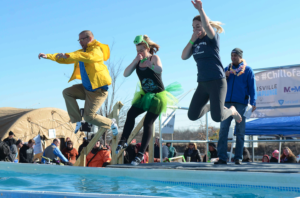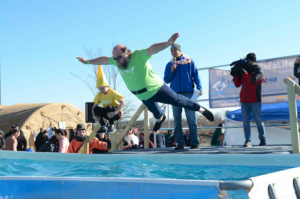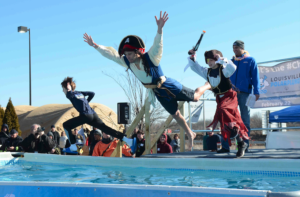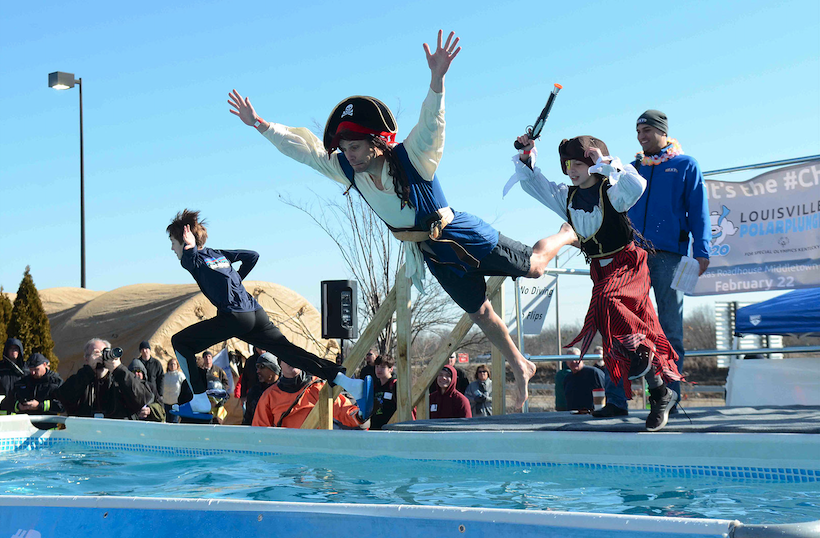Annual Polar Plunge Benefits Special Olympics Kentucky
Writer / Carrie Vittitoe
Photography Provided
 Heavy, gray clouds sit in the sky, and the wind is brisk. You are gathered with friends outside, shivering despite the warmth of bodies around you, and you are mentally preparing yourself to do something you don’t normally do this time of year – jump into an outdoor pool of frigid water in your bathing suit.
Heavy, gray clouds sit in the sky, and the wind is brisk. You are gathered with friends outside, shivering despite the warmth of bodies around you, and you are mentally preparing yourself to do something you don’t normally do this time of year – jump into an outdoor pool of frigid water in your bathing suit.
Each year hundreds of people in Louisville, and even more throughout the state, make this jump as part of the Polar Plunge to benefit Special Olympics Kentucky.
“It is one of the signature fundraising events not just here in Kentucky, but around the country,” says Development Director Jennifer McMahon.
Louisville’s Polar Plunge is the largest in the state and typically raises about $150,000 to help fund Special Olympics activities. McMahon says in its heyday, there were years when this event would raise a quarter of a million dollars and had more than 1,000 people participate.
Time has changed the Polar Plunge, as it changes everything. These days there are all sorts of fundraisers centered on physical activity, such as color runs and “mudder” events, that compete with the Polar Plunge. Some people also consider the Polar Plunge a “bucket list” event; something they want to do one time but don’t feel the need to repeat.
“We have a core group of five or six teams who have participated for 10 years or more,” McMahon says. “That is only about 20% of participants. We have to recruit a new crew of participants every year.”
These days the Louisville Polar Plunge site is at Main Event located off of Blankenbaker Parkway, but for close to two decades the Ohio River was the body of water into which participants jumped.
“Very early on the Polar Plunge was at Waterfront Park near the Great Lawn,” McMahon says. “Then it moved to where the Tumbleweed was located because that is a much more safe location.”
The downside of having an event on the Ohio River is that Mother Nature can foil your plans. During a five-year period, McMahon says participants were only able to jump in the river twice. In one case the event was canceled because the park was flooded.
“That’s not a great business model, for a nonprofit to depend on an event that may or may not take place,” McMahon says.
There are very few Polar Plunge locations that involve a natural body of water, because of unpredictability.
 While lots of people get teams together to participate in the Polar Plunge, it is actually an individual fundraising exercise.
While lots of people get teams together to participate in the Polar Plunge, it is actually an individual fundraising exercise.
“Each individual is challenged to raise or donate a minimum of $75 each,” McMahon says.
Interested participants register online and can connect their participation to their Facebook page.
“They can fundraise through that network, which has really seen huge increases in what each participant is able to fundraise,” McMahon says.
Special Olympics leaders ask individuals, or team captains if individuals have banded together to form a team, to check in the Thursday prior to the event to avoid unnecessary lines and holdups on the day of the plunge.
The Polar Plunge on Saturday is a time of ceremony.
“In a typical year we have a big opening-ceremonies program,” McMahon says.
Athlete leaders speak and share their stories, and sponsors are recognized. This is followed by a costume contest. Teams tend to dress up in coordination. Some teams have every member dressed as a hula girl or a cupid baby, while other teams dress as a well-known group such as Teletubbies, Care Bears and Marvel characters.
The plunge follows the costume contest and while most people opt to put on a bathing suit, there are some who jump into the water in costume. Individuals in elaborate costumes can use the changing tents to put on something more water-appropriate. McMahon suggests people come to the ceremonies in costume but change into family-friendly clothing that is not heavy or clingy, such as a T-shirt and shorts.
“You don’t want jeans and a long-sleeve shirt that’s soaking wet when it is 40 degrees,” McMahon says. “It weighs a lot and makes climbing up the ladder hard. Sometimes you have to wait for a changing room to be open.”
In certain years it has been cold enough for ice to form on the pool water. The pool is set up the day before, holds 9,000 gallons of water and is transported across Kentucky for other Polar Plunge events.
“We raise a minimum of $500,000 each year through these Polar Plunge events,” McMahon says. “It is a big chunk of our budget and has a very large impact on our ability to deliver our programs.”
Those programs are extensive. Special Olympics Kentucky offers 15 sports during four seasons to athletes, including softball, bowling, track and field, swimming, artistic gymnastics, alpine skiing, and bocce.
“We are a year-round sports training and competition program for children and adults with intellectual disabilities,” says Mark Buerger, director of communications and external relations.
While the state summer games are widely known, not everyone realizes the breadth of what Special Olympics Kentucky offers.
Athletes can begin participating in the main sports programs at age 8 and there is no top-out age. Athletes can compete until they simply don’t want to anymore. Buerger says at one point there was an 89-year-old Special Olympian who competed. Special Olympics Kentucky also has a Young Athletes program for children ages 2 to 7, through which children develop the motor and social skills needed to transition into full participation in sports when they turn 8.
Bocce has become a hugely popular sport in the Special Olympics community.
 “Bocce is a great sport for people with mobility issues or who are older,” Buerger says. “The first year we offered bocce as a competitive event we built three bocce courts. Last year at the summer games, I think we built 15. When you go to a Special Olympics event you see the best version of what sports can be in people’s lives.”
“Bocce is a great sport for people with mobility issues or who are older,” Buerger says. “The first year we offered bocce as a competitive event we built three bocce courts. Last year at the summer games, I think we built 15. When you go to a Special Olympics event you see the best version of what sports can be in people’s lives.”
There are no limitations on who can participate in Special Olympics programs.
“We use a process we call divisioning that ensures that anybody who comes to our program has the opportunity to compete at a level where they can be successful and enjoy their experience,” Buerger says.
Athletes are grouped by age, gender and demonstrated ability.
“For a lot of our families, Special Olympics is the first place they’ve gone where there are people who encourage their athletes, who believe their athletes can accomplish things and have expectations of their athletes,” Buerger says.
It is for this reason that people throughout Kentucky willingly jump into potentially ice-cold water to support the mission of the organization.
For more info, visit soky.org/polarplunge.





